+ Open data
Open data
- Basic information
Basic information
| Entry | Database: PDB / ID: 2j1w | ||||||
|---|---|---|---|---|---|---|---|
| Title | Human p53 core domain mutant M133L-V143A-V203A-N239Y-N268D | ||||||
 Components Components | CELLULAR TUMOR ANTIGEN P53 | ||||||
 Keywords Keywords | NUCLEAR PROTEIN / SECOND-SITE SUPPRESSOR MUTATION / DISEASE MUTATION / PHOSPHORYLATION / TUMOR SUPPRESSOR / ALTERNATIVE SPLICING / LI-FRAUMENI SYNDROME / LI- FRAUMENI SYNDROME / HOST-VIRUS INTERACTION / TRANSCRIPTION / METAL-BINDING / ANTI-ONCOGENE / DNA-BINDING / TRANSFERASE / POLYMORPHISM / GLYCOPROTEIN / ZINC / ACTIVATOR / APOPTOSIS / CELL CYCLE / ACETYLATION / P53 DNA-BINDING DOMAIN / TRANSCRIPTION REGULATION / SUPERSTABLE MUTANT / DNA-BINDING PROTEIN | ||||||
| Function / homology |  Function and homology information Function and homology informationnegative regulation of helicase activity / Loss of function of TP53 in cancer due to loss of tetramerization ability / Regulation of TP53 Expression / signal transduction by p53 class mediator / negative regulation of G1 to G0 transition / negative regulation of glucose catabolic process to lactate via pyruvate / Transcriptional activation of cell cycle inhibitor p21 / regulation of intrinsic apoptotic signaling pathway by p53 class mediator / negative regulation of pentose-phosphate shunt / ATP-dependent DNA/DNA annealing activity ...negative regulation of helicase activity / Loss of function of TP53 in cancer due to loss of tetramerization ability / Regulation of TP53 Expression / signal transduction by p53 class mediator / negative regulation of G1 to G0 transition / negative regulation of glucose catabolic process to lactate via pyruvate / Transcriptional activation of cell cycle inhibitor p21 / regulation of intrinsic apoptotic signaling pathway by p53 class mediator / negative regulation of pentose-phosphate shunt / ATP-dependent DNA/DNA annealing activity / Activation of NOXA and translocation to mitochondria / regulation of cell cycle G2/M phase transition / oligodendrocyte apoptotic process / negative regulation of miRNA processing / intrinsic apoptotic signaling pathway in response to hypoxia / regulation of fibroblast apoptotic process / positive regulation of thymocyte apoptotic process / oxidative stress-induced premature senescence / regulation of tissue remodeling / positive regulation of mitochondrial membrane permeability / mRNA transcription / bone marrow development / positive regulation of programmed necrotic cell death / circadian behavior / T cell proliferation involved in immune response / regulation of mitochondrial membrane permeability involved in apoptotic process / germ cell nucleus / RUNX3 regulates CDKN1A transcription / homolactic fermentation / TP53 Regulates Transcription of Death Receptors and Ligands / Activation of PUMA and translocation to mitochondria / TP53 regulates transcription of additional cell cycle genes whose exact role in the p53 pathway remain uncertain / histone deacetylase regulator activity / regulation of DNA damage response, signal transduction by p53 class mediator / negative regulation of glial cell proliferation / Regulation of TP53 Activity through Association with Co-factors / negative regulation of neuroblast proliferation / mitochondrial DNA repair / T cell lineage commitment / Formation of Senescence-Associated Heterochromatin Foci (SAHF) / ER overload response / thymocyte apoptotic process / B cell lineage commitment / TP53 Regulates Transcription of Caspase Activators and Caspases / entrainment of circadian clock by photoperiod / cardiac septum morphogenesis / negative regulation of mitophagy / negative regulation of DNA replication / Zygotic genome activation (ZGA) / positive regulation of release of cytochrome c from mitochondria / PI5P Regulates TP53 Acetylation / Association of TriC/CCT with target proteins during biosynthesis / necroptotic process / TP53 Regulates Transcription of Genes Involved in Cytochrome C Release / negative regulation of telomere maintenance via telomerase / TFIID-class transcription factor complex binding / SUMOylation of transcription factors / TP53 regulates transcription of several additional cell death genes whose specific roles in p53-dependent apoptosis remain uncertain / intrinsic apoptotic signaling pathway by p53 class mediator / rRNA transcription / negative regulation of reactive oxygen species metabolic process / Transcriptional Regulation by VENTX / cellular response to UV-C / replicative senescence / general transcription initiation factor binding / cellular response to actinomycin D / intrinsic apoptotic signaling pathway in response to endoplasmic reticulum stress / positive regulation of RNA polymerase II transcription preinitiation complex assembly / viral process / neuroblast proliferation / intrinsic apoptotic signaling pathway in response to DNA damage by p53 class mediator / positive regulation of execution phase of apoptosis / Pyroptosis / hematopoietic stem cell differentiation / embryonic organ development / response to X-ray / chromosome organization / type II interferon-mediated signaling pathway / somitogenesis / TP53 Regulates Transcription of Genes Involved in G1 Cell Cycle Arrest / hematopoietic progenitor cell differentiation / glial cell proliferation / negative regulation of fibroblast proliferation / positive regulation of cardiac muscle cell apoptotic process / core promoter sequence-specific DNA binding / negative regulation of stem cell proliferation / cellular response to glucose starvation / cis-regulatory region sequence-specific DNA binding / mitophagy / positive regulation of intrinsic apoptotic signaling pathway / Regulation of TP53 Activity through Acetylation / gastrulation / response to salt stress / 14-3-3 protein binding / mitotic G1 DNA damage checkpoint signaling / negative regulation of proteolysis / cardiac muscle cell apoptotic process / transcription repressor complex / MDM2/MDM4 family protein binding / intrinsic apoptotic signaling pathway Similarity search - Function | ||||||
| Biological species |  HOMO SAPIENS (human) HOMO SAPIENS (human) | ||||||
| Method |  X-RAY DIFFRACTION / X-RAY DIFFRACTION /  SYNCHROTRON / SYNCHROTRON /  MOLECULAR REPLACEMENT / Resolution: 1.8 Å MOLECULAR REPLACEMENT / Resolution: 1.8 Å | ||||||
 Authors Authors | Joerger, A.C. / Fersht, A.R. | ||||||
 Citation Citation |  Journal: Proc.Natl.Acad.Sci.USA / Year: 2006 Journal: Proc.Natl.Acad.Sci.USA / Year: 2006Title: Structural Basis for Understanding Oncogenic P53 Mutations and Designing Rescue Drugs. Authors: Joerger, A.C. / Ang, H.C. / Fersht, A.R. #1:  Journal: J.Biol.Chem. / Year: 2004 Journal: J.Biol.Chem. / Year: 2004Title: Crystal Structure of a Superstable Mutant of Human P53 Core Domain. Insights Into the Mechanism of Rescuing Oncogenic Mutations. Authors: Joerger, A.C. / Allen, M.D. / Fersht, A.R. #2:  Journal: J.Biol.Chem. / Year: 2005 Journal: J.Biol.Chem. / Year: 2005Title: Structures of P53 Cancer Mutants and Mechanism of Rescue by Second-Site Suppressor Mutations. Authors: Joerger, A.C. / Ang, H.C. / Veprintsev, D.B. / Blair, C.M. / Fersht, A.R. | ||||||
| History |
|
- Structure visualization
Structure visualization
| Structure viewer | Molecule:  Molmil Molmil Jmol/JSmol Jmol/JSmol |
|---|
- Downloads & links
Downloads & links
- Download
Download
| PDBx/mmCIF format |  2j1w.cif.gz 2j1w.cif.gz | 99.4 KB | Display |  PDBx/mmCIF format PDBx/mmCIF format |
|---|---|---|---|---|
| PDB format |  pdb2j1w.ent.gz pdb2j1w.ent.gz | 75.2 KB | Display |  PDB format PDB format |
| PDBx/mmJSON format |  2j1w.json.gz 2j1w.json.gz | Tree view |  PDBx/mmJSON format PDBx/mmJSON format | |
| Others |  Other downloads Other downloads |
-Validation report
| Summary document |  2j1w_validation.pdf.gz 2j1w_validation.pdf.gz | 440.1 KB | Display |  wwPDB validaton report wwPDB validaton report |
|---|---|---|---|---|
| Full document |  2j1w_full_validation.pdf.gz 2j1w_full_validation.pdf.gz | 443.6 KB | Display | |
| Data in XML |  2j1w_validation.xml.gz 2j1w_validation.xml.gz | 20.7 KB | Display | |
| Data in CIF |  2j1w_validation.cif.gz 2j1w_validation.cif.gz | 30.2 KB | Display | |
| Arichive directory |  https://data.pdbj.org/pub/pdb/validation_reports/j1/2j1w https://data.pdbj.org/pub/pdb/validation_reports/j1/2j1w ftp://data.pdbj.org/pub/pdb/validation_reports/j1/2j1w ftp://data.pdbj.org/pub/pdb/validation_reports/j1/2j1w | HTTPS FTP |
-Related structure data
| Related structure data |  2j1xC  2j1yC  2j1zC  2j20C  2j21C  1uolS S: Starting model for refinement C: citing same article ( |
|---|---|
| Similar structure data |
- Links
Links
- Assembly
Assembly
| Deposited unit | 
| ||||||||
|---|---|---|---|---|---|---|---|---|---|
| 1 | 
| ||||||||
| 2 | 
| ||||||||
| Unit cell |
|
- Components
Components
| #1: Protein | Mass: 24562.789 Da / Num. of mol.: 2 / Fragment: DNA-BINDING CORE DOMAIN, RESIDUES 94-312 / Mutation: YES Source method: isolated from a genetically manipulated source Source: (gene. exp.)  HOMO SAPIENS (human) / Production host: HOMO SAPIENS (human) / Production host:  #2: Chemical | #3: Water | ChemComp-HOH / | Compound details | ENGINEERED RESIDUE IN CHAIN A, MET 133 TO LEU ENGINEERED RESIDUE IN CHAIN A, VAL 143 TO ALA ...ENGINEERED | |
|---|
-Experimental details
-Experiment
| Experiment | Method:  X-RAY DIFFRACTION X-RAY DIFFRACTION |
|---|
- Sample preparation
Sample preparation
| Crystal | Density Matthews: 2.47 Å3/Da / Density % sol: 49.83 % |
|---|
-Data collection
| Diffraction | Mean temperature: 100 K |
|---|---|
| Diffraction source | Source:  SYNCHROTRON / Site: SYNCHROTRON / Site:  SRS SRS  / Beamline: PX14.1 / Wavelength: 1.488 / Beamline: PX14.1 / Wavelength: 1.488 |
| Detector | Type: ADSC CCD / Detector: CCD |
| Radiation | Protocol: SINGLE WAVELENGTH / Monochromatic (M) / Laue (L): M / Scattering type: x-ray |
| Radiation wavelength | Wavelength: 1.488 Å / Relative weight: 1 |
| Reflection | Resolution: 1.8→29.4 Å / Num. obs: 43176 / % possible obs: 95.2 % / Redundancy: 6.9 % / Biso Wilson estimate: 20.5 Å2 / Rmerge(I) obs: 0.07 / Net I/σ(I): 21.2 |
| Reflection shell | Resolution: 1.8→1.9 Å / Redundancy: 6.7 % / Rmerge(I) obs: 0.29 / Mean I/σ(I) obs: 5.7 / % possible all: 90.8 |
- Processing
Processing
| Software |
| ||||||||||||||||||||||||||||||||||||||||||||||||||||||||||||
|---|---|---|---|---|---|---|---|---|---|---|---|---|---|---|---|---|---|---|---|---|---|---|---|---|---|---|---|---|---|---|---|---|---|---|---|---|---|---|---|---|---|---|---|---|---|---|---|---|---|---|---|---|---|---|---|---|---|---|---|---|---|
| Refinement | Method to determine structure:  MOLECULAR REPLACEMENT MOLECULAR REPLACEMENTStarting model: PDB ENTRY 1UOL Resolution: 1.8→29.4 Å / Cross valid method: THROUGHOUT
| ||||||||||||||||||||||||||||||||||||||||||||||||||||||||||||
| Displacement parameters | Biso mean: 23.6 Å2 | ||||||||||||||||||||||||||||||||||||||||||||||||||||||||||||
| Refinement step | Cycle: LAST / Resolution: 1.8→29.4 Å
| ||||||||||||||||||||||||||||||||||||||||||||||||||||||||||||
| Refine LS restraints |
|
 Movie
Movie Controller
Controller



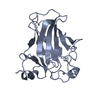







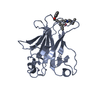
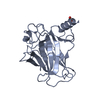


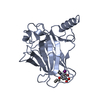
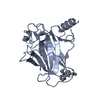
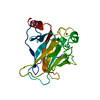

 PDBj
PDBj


















